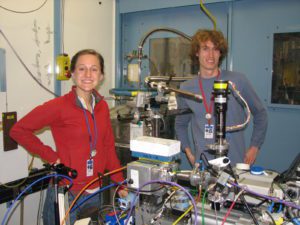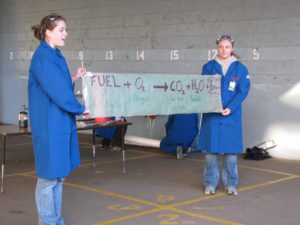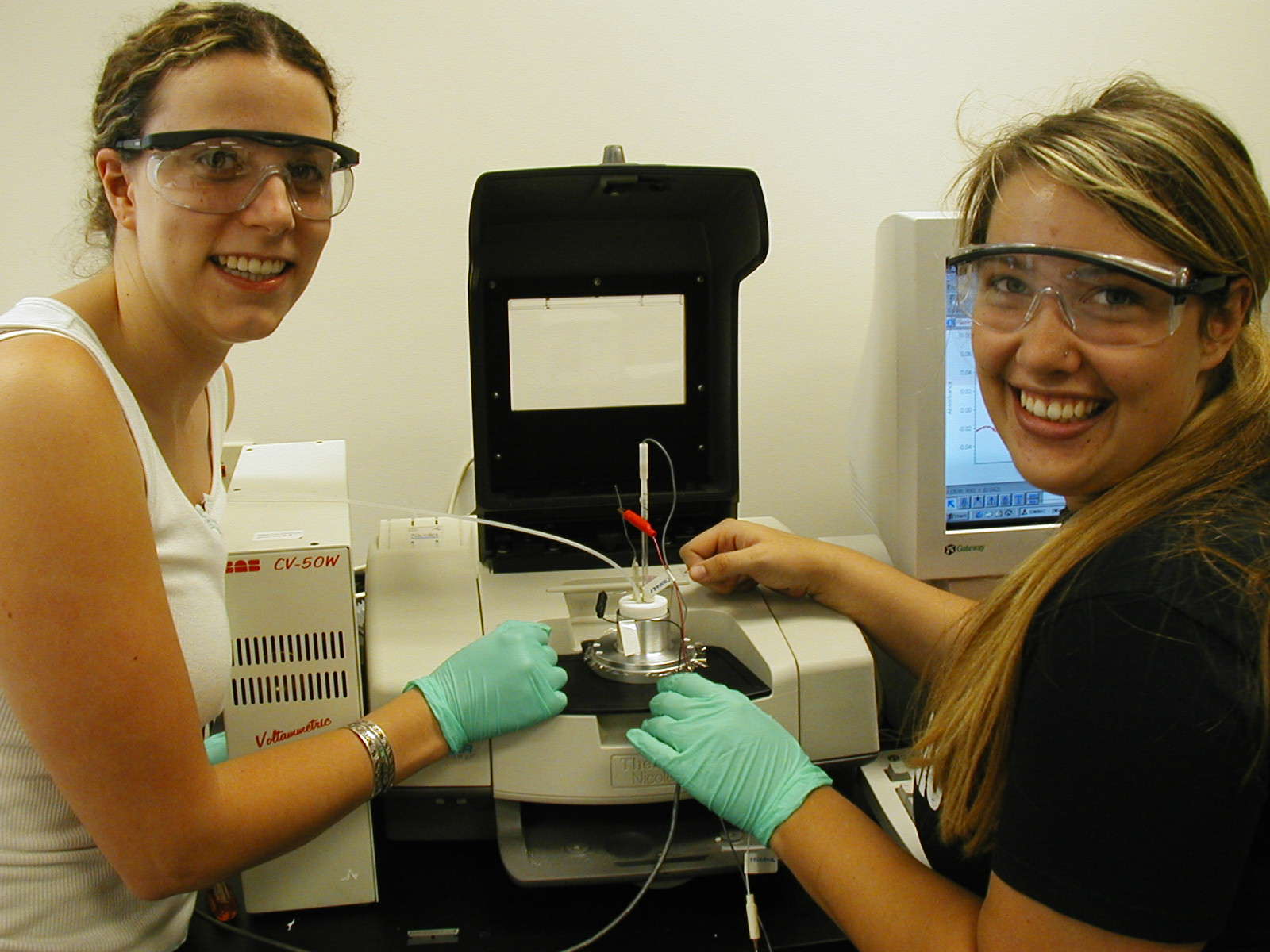A Girl Walks into a Chemistry Lab …
Every good article starts with a story, right? It was my second year as a chemistry major and I walked into the dingy, stinky organic chemistry lab. Worse than stinky, though, it was lonely. We were required to set up our own experiments—no group work.
The professor had told us on the first day of the term that working alone would help us become independent science researchers, so I understood the reasoning, but it never felt quite right. I loved science, but I also loved socializing, listening to music, and joking around.
But in this lab, we barely spoke, the “music” was the hum of the hoods sucking the toxic fumes away from us, and the only jokes were about who was finishing last. I felt forced to work with an invisible bubble around me, pretending to be a confident, independent chemist.
This style of lab culture came as a shock because up to that point, my science lab projects were always collaborative and active. I was used to the professors and teaching assistants buzzing around the room with eager helping hands. But here I felt completely out of sorts. The professor always seemed to be busy with something else, and the nearest student was way down at the far end of the lab bench. I wasn’t even sure what his name was.
One afternoon in lab, we were getting ready to perform our first distillation. I buttoned up my lab coat, secured my hair and goggles, and slid onto my lab stool. I slowly opened my laboratory notebook and kept my eyes low as I opened my supplies drawer and stared at the myriad of flasks, funnels, adapters, and clips. I hesitated as I selected each piece of glassware, timidly glancing up through the corner of my lab goggles to see what others were doing, hoping no one would notice.
My uncertainty grew and seized me like a vice grip, and I could feel myself sweating through my lab coat even though the air in the lab was cool. My determination carried me forward, though, as I used my invisible bubble of solitude to gain focus. As the apparatus took form, I began to sit taller on my stool, and eventually I pushed the stool away to stand up and reach up high to clamp the final piece of the distillation column in place. I stepped back and felt a twinge of a smile on my face as I looked at my apparatus and felt pride swelling up inside of me.
Just then, I heard a booming voice from the other end of the lab bench—it was, of course, the professor, Dr. Green. While he was often absent, when he decided to engage with us he always made sure his presence dominated.
“Vern is a fine young man!” he proclaimed, slapping my fellow student on the shoulder in a familiar colleague-style manner.
Dr. Green lingered at Vern’s bench for a few minutes longer, chatting and nodding vigorously as he gave Vern’s apparatus the once-over. I quickly looked back at my setup, and I could feel my face widen as a true grin emerged. Mine was constructed perfectly, and I had done it all by myself!
I scribbled a quick note in my lab notebook, getting ready for Dr. Green to stop by my lab bench next to give me a thumbs-up too. I knew full well it would not have the same kind of 1960s-Good-Ol’-Boys-Club kind of style as Vern had experienced, but I did not expect what happened next. Or, more precisely put, what did not happen.
I didn’t hear Dr. Green’s booming voice again, nor did I hear his voice near me at all. Instead, I felt the “whoosh” of his lab coat as he whisked past me, taking no notice of me nor my work or carefully aligned glassware. He didn’t see that my lab notebook had been dated and signed, nor the sketch that we had been taught to do, nor the summary of the chemical mixture we were assigned to distill along with their known boiling point temperatures.
I was invisible.
At first I felt confused, peering around the laboratory, thinking that he had been pulled away suddenly for a question or emergency. But there he stood on the other side of the lab, leaning up against the wall with the teaching assistant, chuckling about something unrelated to the lab project.
My mind grappled at how intensely he had ignored me in that moment. As my lips pursed, I gazed back with dead eyes at my apparatus that was perfectly poised for a seamless distillation. In this long pause, there was nothing left to ponder or cross-check. I landed at the only explanation for what felt like a purposeful dismissal. Since there was nothing wrong with my work, the only thing wrong must have been me.
It sounds like I hated organic chemistry lab, doesn’t it? It might be surprising to hear that I absolutely loved it. When it came down to the science aspects of that lab, I was smitten. I adored the fancy glassware, I savored the satisfaction of snugly fitting two pieces of glassware together, and I marveled at the elegance of each apparatus that I built.
But best of all, I reveled in getting to create and watch the chemical reactions that we had learned about in lecture. The chalkboard scrawls, which only told me what was “supposed” to happen, had life breathed into them in lab. These experiences made my mind and body feel bright and vibrant!
Those feelings of vibrancy are what carried me through the rest of the term and through the rest of my studies as I forged ahead. Exactly eight years later after that day in lab, I completed my chemistry Ph.D. and fully stepped into my mission of becoming a supportive and dynamic chemistry professor.
But what if I hadn’t had as much of a spark that carried me through? How many science students out there are crushed with just one careless act like I had that day? How many students decide that they can’t do it, and give up on their dreams of med school, graduate school, or the lab job they thought they wanted?
Too many. I believe that every student should have the chance to have their big and small successes celebrated, to be seen and heard as their curiosity grows, and to only stop their science studies if they truly decide if it’s not for them—not because of an unsupportive environment.
While I’ll never forget that feeling of being invisible and ignored, that experience served an important purpose. It was the seed that led me to become a chemistry professor who works hard to see and support students, and it was the impetus for me to later create Science Rockstar Kids, an online interactive science program for elementary school children. My decades of teaching students of all ages became an extension of what I learned that day in organic chemistry lab: a formula for student success.

Dani & Jeff getting to do research at a particle accelerator at Stanford
What is Success?
It’s just too tempting to let the scientist in me emerge fully and write a formula:
C + C + C = S
The letter S stands for success, but let’s discuss the word “success” for a minute. To me, it’s not just receiving a score of 95% on an exam. Each student knows how success feels to them, and the details of what led to that feeling can vary widely from person to person. Some might have been paralyzed by imposter syndrome that they were finally able to overcome. Others may have grappled with fear of judgment that prevented them from sharing their results and discuss science with others, and they finally found the courage to speak. Others may have felt uninspired and bored, unable to see the importance of scientific concepts to everyday life, and they mustered the energy to dig deep and find the connections that allowed them to feel awe.
Keystone #1
To achieve the level of success that’s meaningful for each science student, I believe that a combination of three keystones is imperative, which is what I showed on the left side of the equation: C + C + C. The first keystone is Content. Solid content in is imperative so that student can sink their teeth into it and see how it is important to them and the world around us. The inspiration varies; some are inspired by nutrition and human physiology, others by how to be a better steward of Planet Earth, and others marvel at science just for the sake of science.
Keystone #2
The second keystone is Communication. This is where ideas and problem solving comes to life, where there is a two-way street of sharing. The synergy of minds is incredible, especially when science students are in small groups and have ample opportunities to express their thoughts, listen to others, and grapple with big questions together. This is an opportunity for people to find strengths and weaknesses in themselves and the group, and to identify leadership in them that may not have been obvious in other arenas in life.
Keystone #3
And the third keystone is Community. Because this is all about having fun together! This is where my love of socializing, joking around, and playing music comes to light. Why can’t we have our bluetooth speakers in the lab and all of us can take turns playing deejay? Why can’t we take breaks during our online experiment to play a short song and dance together? The answer is that we can—and we do! It’s a little more challenging online, but we did it in both my kids science program and we do it livestreaming on Twitch. The idea that discoveries come from a lone scientist in lab is a myth!

The Bonus Side Products
While the end result can be called “S” for success, there are two other side-products that I’ve observed: science students become empowered and excited. Empowerment and enthusiasm go a long way, instilling more confidence, carrying these young critical thinkers into their futures in whatever they choose to do, whether it’s related to science or not.
So now, as a professor and educator, it’s the not just the content that I teach. I purposefully combine solid Content, Communication, and Community. My students get to learn and enjoy not just the science, but grow as scientists together, with fun and encouragement. I work to create spaces where no one is invisible. No on is ignored. And no one leaves without the feeling that they have the tools to become empowered and excited to be a scientist.
Karen McFarlane Holman, Ph.D., is a chemistry professor at Willamette University. She was awarded Oregon Professor of the Year from the Carnegie Foundation in 2010 and is the Founder and Director of Science Rockstar Kids, a unique online science program, as well as programs for adults.

Solayah, from Canada, extracts DNA from strawberries in Karen Holman’s Science Rockstar Kids program
